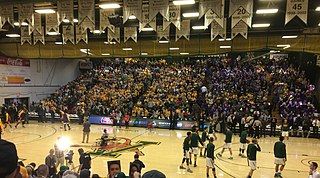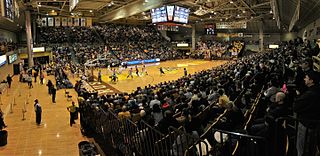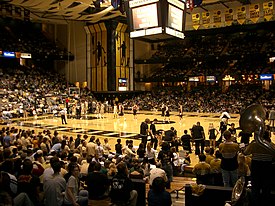
Williams Arena is an indoor arena located in Minneapolis, Minnesota. It is the home arena for the University of Minnesota's men's and women's basketball teams. It also housed the men's hockey team until 1993, when it moved into its own building, 3M Arena at Mariucci. The building is popularly known as The Barn, and its student section is known as "The Barnyard".

The Palestra, often called the Cathedral of College Basketball, is a historic arena and the home gym of the Penn Quakers men's and women's basketball teams, volleyball teams, wrestling team, and Philadelphia Big 5 basketball. Located at 235 South 33rd St. in Philadelphia, Pennsylvania on the campus of the University of Pennsylvania, near Franklin Field in the University City section of Philadelphia, it opened on January 1, 1927. The Palestra has been called "the most important building in the history of college basketball" and "changed the entire history of the sport for which it was built".

Hank McCamish Pavilion, nicknamed The Thrillerdome and originally known as Alexander Memorial Coliseum, is an indoor arena located on the campus of the Georgia Institute of Technology in Atlanta, Georgia. It is the home of the Georgia Tech Yellow Jackets men's basketball and Yellow Jackets women's basketball teams.

Rupp Arena at Central Bank Center is an arena located in downtown Lexington, Kentucky, United States. Since its opening in 1976, it has been the centerpiece of Central Bank Center, a convention and shopping facility owned by an arm of the Lexington-Fayette Urban County Government, which is located next to the Lexington Hyatt and Hilton hotels. Rupp Arena also serves as home court to the University of Kentucky men's basketball program, and is named after legendary former Kentucky coach Adolph Rupp with an official capacity of 20,500. In 2014 and 2015, in Rupp Arena, the Kentucky Wildcats men's basketball team was second in the nation in college basketball home attendance. Rupp Arena also regularly hosts concerts, conventions and shows.

Thompson–Boling Arena at Food City Center is a multi-purpose arena on the campus of the University of Tennessee in Knoxville, Tennessee. The arena opened in 1987. It is home to the Tennessee Volunteers (men) and Lady Vols (women) basketball teams. Since 2008, it has been home to the Lady Vols volleyball team. It is named after B. Ray Thompson and former university president Edward J. Boling. The basketball court is named "The Summitt" after the late Lady Vols basketball coach Pat Summitt. It replaced the Stokely Athletic Center. The mammoth octagonal building lies just northwest of the Tennessee River, and just southwest of Neyland Stadium. As an echo of its neighbor and a tribute to the brick-and-mortar pattern atop Ayres Hall, the baselines of the court are painted in the familiar orange-and-white checkerboard pattern.

The Pete Maravich Assembly Center is a 13,215-seat multi-purpose arena in Baton Rouge, Louisiana. The arena opened in 1972. It was originally known as the LSU Assembly Center, but was renamed in honor of Pete Maravich, a Tiger basketball legend, shortly after his death in 1988. Louisiana governor Buddy Roemer signed an act to rename the building in Maravich's honor. Maravich never played in the arena as a collegian but played in it as a member of the Atlanta Hawks in a preseason game. But his exploits while at LSU led the university to build a larger home for the basketball team, which languished for decades in the shadow of the school's football program. The Maravich Center is known to locals as "The PMAC" or "Pete's Palace", or by its more nationally known nickname, "The Deaf Dome", coined by Dale Brown. The Maravich Center's neighbor, Tiger Stadium is known as "Death Valley".

The Roy L. Patrick Gymnasium is a 3,228-seat multi-purpose arena in Burlington, Vermont. It was built in 1963 to replace the Old Gymnasium, a then-60-year-old facility now known as the Royall Tyler Theater. It is used mainly as the home arena of the Vermont Catamounts men's and women's basketball teams. It has been the site of the 2004, 2005, 2007, 2010, 2013, 2017, 2018, 2019, and 2022 America East men's basketball tournament championship games, as the higher seed in the final hosts the game. The championship games were all televised on ESPN or ESPN2. Vermont has consistently been among the America East leaders in home attendance and in 2004–05, it became the only America East men's basketball program to sell out every game for an entire season.

The Vanderbilt Commodores are the intercollegiate athletic teams that represent Vanderbilt University, located in Nashville, Tennessee. Vanderbilt fields 16 varsity teams, 14 of which compete at the National Collegiate Athletic Association (NCAA) Division I level as a member of the Southeastern Conference (SEC). Vanderbilt's women's lacrosse team plays in the American Athletic Conference. The bowling team plays in Conference USA (C-USA), which absorbed Vanderbilt's former bowling home of the Southland Bowling League after the 2022–23 season. The University of Tennessee Volunteers are Vanderbilt's primary athletic rival, and the only other SEC team in Tennessee.

Charles M. Murphy Athletic Center is the name of the main athletic department building at Middle Tennessee State University in Murfreesboro, Tennessee. The building opened December 11, 1972, and is named in honor of former athletics director Charles M. "Bubber" Murphy, a standout athlete at the college in the 1930s, who also served as head coach of Middle Tennessee State's football (1947–1968), basketball (1948–1949), and baseball programs.

Memorial Coliseum is an 8,500-seat multi-purpose arena in Lexington, Kentucky. The facility, which opened in 1950, is home to four women's teams at the University of Kentucky – basketball, volleyball, gymnastics, and STUNT. Before Rupp Arena opened in 1976, it also housed the men's basketball team. Memorial Coliseum also housed the university's swimming and diving team prior to the 1989 completion of the Lancaster Aquatics Center.

The Memorial Athletic and Convocation Center, often referred to as the MAC Center and the MACC, is a multi-purpose arena on the campus of Kent State University in Kent, Ohio, United States. The building is primarily used as an athletic venue that is home to five Kent State Golden Flashes varsity athletic teams, including the men's basketball and women's basketball teams. The arena also hosts women's volleyball, women's gymnastics, and wrestling as well as commencement exercises, speakers, and concerts throughout the year. The building houses the offices of the Kent State Athletic Department and the coaches of each of the university's varsity athletic teams.

The Athletics–Recreation Center, also known as the ARC, is a 5,000-seat multi-purpose arena on the campus of Valparaiso University in Valparaiso, Indiana, United States. It serves as the home court for Valparaiso Beacons men's and women's basketball teams as well as the volleyball team. It opened in 1984 as an addition to Hilltop Gym, the oldest parts of which date to 1939.

McDonough Gymnasium, sometimes referred to as McDonough Arena when hosting a sports or entertainment event, is a multi-purpose arena on the campus of Georgetown University in Washington, D.C. Officially known as McDonough Memorial Gymnasium, it opened in 1951 and can hold 2,200 spectators for sports events.

Walsh Gymnasium is a multi-purpose arena in South Orange, New Jersey on the campus of Seton Hall University. The arena opened in 1941 and can seat 1,316 people. It was home to the Seton Hall Pirates men's basketball team before they moved to the Meadowlands in 1985 and then Prudential Center in 2007. Currently, the arena hosts the women's basketball and volleyball teams, but continues to host men's basketball for preseason exhibitions, postseason invitational games such as early rounds of the NIT, and occasionally a regular season non-conference game if there is a conflict with Prudential Center's event schedule. The building is part of the Richie Regan Recreation & Athletic Center, and, like the school's main library, is named for Rev. Thomas J. Walsh, fifth bishop of Newark and former President of the Board of Trustees.

The LSU Tigers and Lady Tigers are the athletic teams representing Louisiana State University (LSU), a state university located in Baton Rouge, Louisiana. LSU competes in Division I of the National Collegiate Athletic Association (NCAA) as a member of the Southeastern Conference (SEC).

The Vanderbilt Commodores men's basketball team represents Vanderbilt University in the Southeastern Conference (SEC). The Commodores have won three SEC regular-season titles and two SEC Tournament championships. They have competed in 15 NCAA Tournaments, making it to the Elite Eight once (1965) and the Sweet Sixteen six times. Vanderbilt has played in 14 National Invitation Tournaments, winning it in 1990 and finishing runners-up in 1994.
McCarthy Gymnasium was a 3,000-seat multi-purpose arena located on the Mississippi State University campus. It opened in 1950 directly east of the "Tin Gym", MSU's previous on-campus arena that had opened in 1929. It was originally known as the Mississippi State Gymnasium, or the New Gym for short. When it opened, the facility held over 5,000 people. It was renamed for former MSU men's basketball coach James H. "Babe" McCarthy after his death in 1975. The facility had a seating capacity of 5,000 when it first opened in 1950, but capacity was reduced to the current 3,000 when retractable seating was removed. It was home to the Mississippi State University Bulldogs basketball teams until the Humphrey Coliseum opened in 1975 and has been home to the MSU Tennis teams since 1999.

The University of Missouri–St. Louis (UMSL) Tritons are the athletic programs represent the University of Missouri–St. Louis. They compete in NCAA Division II and are members of the Great Lakes Valley Conference. Following a student contest in 1965, the athletic teams were commonly known as the Rivermen and Riverwomen, used until the Tritons name was adopted in May 2007.
The 2001 SEC Men’s Basketball Tournament took place on March 8–11, 2001 in Nashville, Tennessee at the Gaylord Entertainment Center.

The Vanderbilt Commodores women's basketball team represents Vanderbilt University in the Eastern Division of the Southeastern Conference (SEC). The Commodores have never won the regular season SEC championship, although they have won six SEC tournament titles ; the SEC has awarded its official championship based solely on regular-season record since the 1985–86 season. The team is coached by Shea Ralph, entering her third season.


















